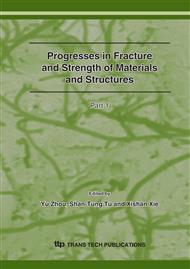p.116
p.120
p.126
p.130
p.134
p.138
p.142
p.146
p.150
Effect of Contact Pressure and Cyclic Stress Amplitude on Fretting Fatigue of 45-Carbon Steel
Abstract:
The effect of contact pressure on fretting fatigue in quenched and tempered 45-carbon steel is studied. With an increase in contact pressure, fretting fatigue life is decreased quickly at low contact pressures; however it almost unchanged at high contact pressures. With an increase in cyclic stress amplitude, fretting fatigue life decreased. In the test, concavity is formed at the fretted area accompanying wear. The main crack is initiated at the outer edge corner of the concavity at high contact pressures, and initiated at the middle portion of the fretted area at low contact pressures.
Info:
Periodical:
Pages:
134-137
Citation:
Online since:
September 2007
Authors:
Keywords:
Price:
Сopyright:
© 2007 Trans Tech Publications Ltd. All Rights Reserved
Share:
Citation:


